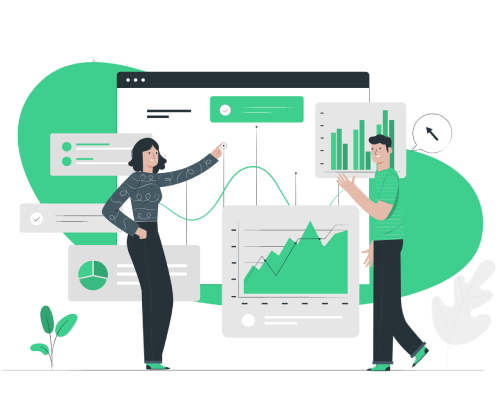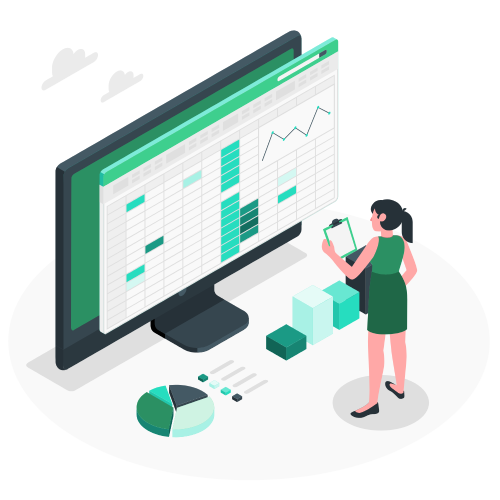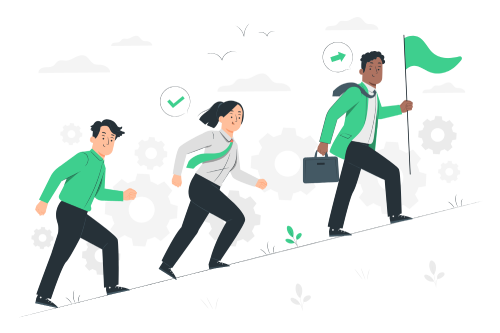Data visualization
Introduction to Data Visualization: Examples and Implementation
In the current digital era, businesses are flooded with data on an unprecedented scale. Yet, these data are merely numbers and statistics until they are transformed into meaningful information. This is where data visualization comes into play. It brings data to life by turning it into impactful and understandable visuals.
Instead of scrolling through endless spreadsheets or trying to decipher complex data reports, you can instantly understand trends at a glance. That’s the power of data visualization.
Whether you are an IT professional, a marketing specialist, a project manager, or an entrepreneur, data visualization is a critical skill that can transform the way you approach data.
Summary
What is Data Visualization?
Data visualization, often referred to as dataviz for data visualization in English, is a visual approach to representing data and information in an understandable and effective manner. It is an essential tool in the field of process management and efficiency optimization.
Dataviz involves using graphs, charts, diagrams, and other visual elements to make complex data more accessible and easier to interpret. It facilitates easier decision-making by highlighting trends, patterns, and key insights in the data.

What are the Benefits of Data Visualization for Businesses?
Data Understanding: Data visualization transforms raw data into easy-to-understand graphs, charts, and visual diagrams. This facilitates the comprehension of key information.
Decision Making: Dataviz simplifies the complexity of data by presenting it visually, thus aiding professionals in making informed decisions.
Effective Communication: It's a powerful tool for communicating complex information across different levels of the organization. It promotes collaboration and alignment.
Problem Identification: By visualizing data, it becomes easier to spot issues or bottlenecks in processes. This allows for the identification of areas that require improvement.
Benchmarking: By visually comparing different data sets, professionals can uncover correlations, disparities, or opportunities for optimization.
Highlighting the Essentials: By using charts, dashboards, and diagrams, dataviz allows for the highlighting of key data and crucial KPIs (Key Performance Indicators). This prevents drowning in an excessive amount of information and enables a focus on what is truly important.
What are the Application Areas of Dataviz?

Tools:
- Business Intelligence (BI): It enables businesses to transform their data into interactive reports and dashboards, facilitating data-driven decision-making.
- Business Process Management (BPM): It can be used to map and optimize business processes, identifying weaknesses, delays, and potential improvements.
- Customer Relationship Management (CRM): Dataviz can help businesses track sales performance, analyze customer data, and visualize trends to better understand their customer base.

Industry Sectors:
- Healthcare: In the healthcare sector, it can be used to track medical data, monitor outbreaks, analyze public health trends, and assist healthcare professionals in making informed decisions.
- Finance: Financial companies use dataviz to track markets, analyze investment portfolios, detect fraud, and present financial reports in a clear and visual manner.
- Education: In education, it is used to analyze student performance, track progress, and help teachers personalize instruction based on individual needs.
- Marketing: Data visualization assists marketers in tracking advertising campaigns, analyzing consumer behavior, and visualizing social media data.
- Transport and Logistics: Transportation companies use dataviz to track routes, monitor shipment logistics, optimize fleet management, and improve operational efficiency.
- Environment:In the environmental field, it is used to visualize climate data, track air and water quality, and analyze environmental trends.
- Human Resources: HR professionals use data visualization to analyze workforce data, track employee performance, and optimize recruitment processes.
These areas represent just a small portion of the industry sectors that use dataviz. In reality, it can be used in nearly every sector to improve decision-making, optimize processes, and better understand data.
What are the Different Types of Visualizations?
There are many types of data visualizations, each suited to specific types of data and particular communication objectives. Here are some of the most commonly used types of visualizations:
- Bar Charts: They are used to compare discrete data categories. The bars can be horizontal (horizontal bars) or vertical (vertical bars).
- Histograms: They show the distribution of continuous data by grouping values into intervals (bins) on the horizontal axis and displaying the frequency or density on the vertical axis.
- Pie Charts: They represent the share of each category relative to a whole.
- Line Charts: They display continuous data as curves, ideal for visualizing trends and variations over time.
- Scatter Plots: They are used to display the relationship between two continuous variables. Each point represents a pair of values.
- Geographic Maps: They display spatial data on a map, allowing for the visualization of information by region or geographic location.
- Box Plots: They show the statistical distribution of data, including the median, quartiles, and outliers.
- Heatmaps: They represent data using a color palette to show the density or intensity of values in a matrix.
- Stacked Bar Charts: They show the contribution of each category to a whole, by stacking the bars on top of each other.
- Chord Diagrams: They illustrate connections and relationships between different categories.

Each type of visualization has its advantages and disadvantages, and the choice will depend on the specific data your clients wish to represent. It is important to select the most appropriate visualization to clearly present the information contained in the data.
What is Data Storytelling?
Data Storytelling, or data narration, is an approach that involves telling stories through data. It combines the power of data visualization with storytelling to create informative narratives from the information contained in the data. The goal of Data Storytelling is to make data more understandable and engaging for the audience.
Here are some key elements of Data Storytelling:
Narrative: Data Storytelling starts with a story. This can be an initial situation, a challenge to overcome, or an opportunity to exploit. The story creates a context for the data.
Visualization: The data are transformed into visualizations, such as graphs, interactive dashboards, or maps. These visuals help to illustrate the key points of the story.
Narrative Structure: As in any good story, there is a narrative structure. There is an introduction, development, a conflict or challenge, a climax (decisive moment), and a resolution. The data are presented in a way that follows this structure.
Personalization: The characters in the story can be individuals, groups, or even companies. The audience can identify with these characters, making the story more engaging.
Context: The data are placed in a broader context to help the audience understand their relevance. The context can include historical trends, comparisons, or goals to be achieved.
Key Message: Every Data Storytelling story has a key message to convey. The data are used to support this message.
Interactivity: In some cases, Data Storytelling can be interactive, allowing the audience to explore the data themselves and draw their own conclusions.

Example of Data Storytelling:
Imagine a company looking to improve its inventory management process. Instead of simply presenting tables of raw numbers, Data Storytelling allows for the creation of a story. It starts with an initial situation: high inventory levels, increasing storage costs, and difficulties in predicting demand.
Next, a main character is introduced: the improved inventory management system. The data become the events of the story. It shows how this system was implemented and how it began to optimize inventory levels using charts and diagrams.
The conflict arises in the form of challenges encountered along the way, such as initial integration problems or necessary adjustments in the process. However, through the data, it is shown how these obstacles were successfully overcome, thanks to the increased efficiency of the new system.
Finally, the story reaches its conclusion: reduced inventory levels, controlled storage costs, and improved customer satisfaction due to faster delivery. The data narrate how the software transformed the initial situation into a business success.
Data Storytelling makes data more accessible and engaging for decision-makers. It helps to contextualize information, reveal insights, and influence decisions. Whether for business presentations, analytical reports, or marketing communications, Data Storytelling is a powerful skill for effectively conveying data-based information to a diverse audience.
What are the Criteria to Consider When Choosing Your Dataviz Solution?
1
Usability: The solution should be user-friendly and intuitive so that users, even those without advanced technical skills, can easily create data visualizations.
2
Interoperability: It is essential that the solution integrates well with other systems and data sources that businesses already use, such as ERP, BPM, and CRM.
3
Visualization Types: Ensure that the solution offers a variety of visualization types to meet the specific needs of your business, such as charts, interactive dashboards, maps, etc.
4
Customization: The ability to customize visualizations to match the company's visual identity is important. Users should be able to tailor the charts to the specific needs of their reports.
5
Data Interoperability: The solution must be capable of connecting to various data sources, whether stored locally or in the cloud. Data importing should be seamless and efficient.
6
Data Security: Data security is crucial; the solution must offer advanced security features to protect sensitive information.
7
Performance: The tool must be capable of handling datasets of various sizes without compromising performance. This includes the loading speed of visualizations and the responsiveness of interactive dashboards.
8
Ease of Sharing: It should be easy to share visualizations with other users within the company. The ability to generate links or embed visualizations in reports is a plus.
9
Scalability: The solution must be scalable to accompany the growth of the business. It should be able to handle an increasing number of users and data.
10
Training and Support: Check if the solution offers training for users and quality customer support in case of issues or questions.
11
Mobile Compatibility: An increasing number of users view data visualizations on mobile devices. Ensure that the solution offers a user-friendly experience on these platforms.
By considering these criteria, businesses can choose a dataviz solution that meets their specific needs in terms of process management, efficiency, and productivity, while ensuring an optimal user experience and data security.
How to Train Yourself in Data Visualization Tools?
Training in data visualization tools is essential for professionals who wish to fully leverage the potential of these tools.
First, identify the most commonly used dataviz tools in your field. Popular solutions include Tableau, Power BI, QlikView, Google Data Studio, and many others. Choose those that best suit your needs.
Many online platforms offer courses and tutorials. Sites such as Coursera, edX, Udemy, and LinkedIn Learning provide both paid and free courses that cover a range of skills, from introductory to advanced levels.
Dataviz tool providers usually offer comprehensive documentation and user guides. This is a valuable resource for learning the specific features of each tool.
There are many books that cover both fundamental concepts and practical use of tools. Look for recommended books in this field.
If you prefer in-person learning, search for face-to-face training courses or workshops available in your region. These sessions are often conducted by experts in the field.


You can also join online communities, discussion forums, and social media groups dedicated to dataviz. You can ask questions, share your knowledge, and learn from the experiences of other professionals.
Practice is essential for mastering this skill, so don’t hesitate to create personal or professional projects where you can apply what you have learned. The more you handle data and create visualizations, the more skilled you will become.
If possible, find a mentor or an experienced colleague in the field. Working with someone who has experience can accelerate your learning.
Some online training platforms offer official certifications that can enhance your professional credibility.
Finally, you can review examples of successful data visualizations to understand design and interactivity techniques.
By combining these learning methods, you can acquire solid skills and apply them in your work as a professional software developer. Continuous training is crucial in this field to stay competitive and offer effective solutions to your clients.
Discover how our ERP can help improve your company’s performance
An expert will contact you shortly to discuss your project.